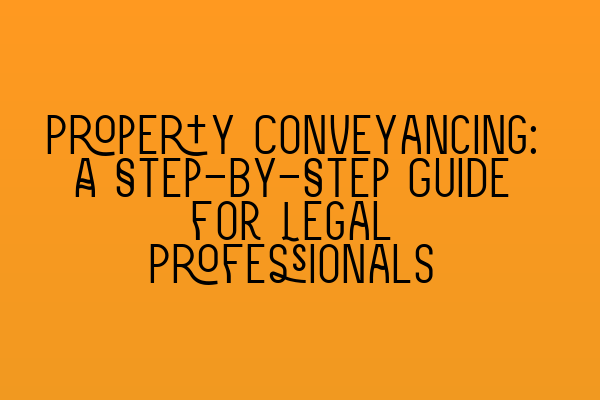Property Conveyancing: A Step-by-Step Guide for Legal Professionals
Welcome to SQE Property Law & Land Law, where our team of highly skilled solicitors specialize in property conveyancing. In today’s blog post, we will provide a comprehensive, step-by-step guide for legal professionals involved in property conveyancing. Whether you are a newly qualified solicitor or an experienced practitioner, this guide will prove invaluable in ensuring a smooth and efficient conveyancing process for your clients.
1. Preliminary Steps
The first step in any property conveyancing process is to obtain the necessary information and documentation. This includes conducting searches, obtaining planning permissions and building regulation approvals, and reviewing title deeds. It is important to carry out these preliminary steps thoroughly to avoid any pitfalls later on in the process. For more practice questions on property conveyancing, check out our SQE 1 Practice Exam Questions.
2. Drafting Contracts
Once you have gathered all the relevant information, it is time to draft the contracts. These contracts will outline the terms and conditions of the property sale, including the purchase price, completion date, and any additional provisions. It is crucial to ensure that the contracts are clear, concise, and legally binding. For additional practice, you can attempt our SQE 1 Practice Mocks FLK1 FLK2.
3. Exchange of Contracts
The exchange of contracts is a significant milestone in the conveyancing process. At this stage, both the buyer and the seller become legally bound to the transaction. It is essential to ensure that all the necessary checks, such as confirming the financial arrangements and verifying the identity of the parties, have been completed before proceeding with the exchange. Our SQE 2 Preparation Courses can provide you with further guidance on contract exchanges.
4. Completion
Completion is the final stage of the conveyancing process, where the buyer completes the purchase and takes possession of the property. This involves transferring the purchase price to the seller, registering the transfer of ownership, and obtaining the keys to the property. It is essential to ensure that all necessary payments and documentation are in order to facilitate a smooth completion. Our SQE 1 Preparation Courses can assist you with honing your skills in property conveyancing.
5. Post-Completion Matters
Following completion, there are still a few tasks to be carried out. These include paying stamp duty land tax, updating relevant authorities with the change of ownership, and registering any existing mortgages on the property. It is crucial to complete these post-completion matters promptly and accurately to finalize the transaction. For information on SRA SQE Exam Dates, visit our website.
6. Additional Considerations
In addition to the main steps outlined above, there are various additional considerations to keep in mind during the conveyancing process. These include dealing with leasehold properties, handling disputes, and advising on tax implications for the buyer or seller. It is crucial to have a thorough understanding of these additional considerations to provide comprehensive advice to your clients.
In conclusion, property conveyancing is a complex and multifaceted process that requires careful attention to detail and sound legal knowledge. By following this step-by-step guide, legal professionals can ensure a smooth and efficient conveyancing experience for their clients. Remember to stay up to date with the latest changes to property law and consider further professional development through our SQE 2 Preparation Courses.
